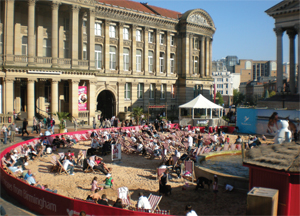Glorious mud
Andrew Ormston explores how festivals can contribute to regeneration during difficult economic times.

The growth in festivals and events across the UK has been spectacular. Industry advocates confidently make the case that festivals are a central part of our cultural life. Why is this happening? Are we fed up with television? Does niche broadcasting mean that we miss the community experience of cultural consumption? Do traditional venues feel institutionalised? Do we just crave fresh air and mud? One factor in festivals’ growth is that more investors see reasons to invest in the first place. An inevitable corollary is that more claims are made for the positive impacts of investment. Regenerate your area and reinforce its positive identity. Animate public space and sustain local retail and catering. Improve the skills of the local workforce. Attract visitors and enhance community life.
Impact assessment
The focus tends to be on the large scale. The fiercely competitive response to the call to host the European Capital of Culture in 2008 was surprising – add competitive civic leadership and pride to the list of festival drivers. Huge amounts of money were invested, and this has resulted in positive legacies in cities around the country. ‘Impacts 08’ is the resulting research programme in Liverpool. The aim is to create a holistic approach that combines the economic, social, cultural and environmental impacts of the year. When this research is combined with similar analysis of London 2012 and Glasgow 2014 we will have a compelling body of evidence that shows that large-scale events are earning their place as both cultural and regenerative agents. UK Sport has produced a convincing body of research concerning the economic impact of major sporting events. If your ambition is to host an international track championship, you need good arguments to use on the guardians of the public purse. The British Arts Festivals Association’s analysis of 2006 (where 80 member organisations delivered 193 events, attracting five million attenders, and contributing £42m to the economy) is heady stuff for those of us who enjoy our performance live.
The green agenda
The commercial case for music festivals is well rehearsed. It is now less a case of festivals being a showcase for an industry, as being an industry in themselves. The annual calendar is bewilderingly populous, alarmingly mainstream to my generation (the Times produce a ‘Festival Guide’!), and increasingly damp. Festivals’ environmental credentials are more debatable. ‘Green’ is a strong promotional message, and organisers haven’t been slow to pick up on this. This is being addressed by using energy-efficient stage and lighting rigs, for example. But a festival’s main carbon footprint comes from transport. Thirty thousand audience members don’t begin walking the previous week to get there. Conversely, how do you compare this impact with another 30,000 people doing dispersed activities over the same weekend, and with the positive impact of environmental advocacy stalls and activities at festivals?
Local knowledge
Events tend to be expensive and carry risk. If you live near a festival site, you know the downside. Noise, traffic jams and irresponsible parking are all familiar complaints. My own treasured moment on a complaint hotline – “my God, they’re swimming in my pool!” Locals know it’s a great time to have that noisy party – just blame it on the event down the road. Yet research shows that a sustainable festival needs local support. People must perceive the benefits – to their local economy, sense of place, and cultural life – as outweighing the nuisance. This is both a communications and a planning issue. Can you give opportunities to local artists and suppliers, and align with destination marketing efforts? Can you produce the evidence that this has a positive effect?
Small- and middle-scale events are the iceberg under the large-scale televised events tip. As a sector, we don’t pay as much attention to them. I wonder if the cumulative economic, social and cultural impacts of small events would make their much larger companions seem relatively small beer. However, these events often use volunteers and cannot afford to divert resources to assessing impact. They tend to fall below the horizon of the visitor economy and regeneration professionals requiring evidence. We need to figure out how to embed impact analysis into standard events planning and practice, in much the same way that health and safety is embedded. We need to provide a workable set of guidelines to any festival organiser in receipt of public investment.
Avoiding the crunch
So what’s the problem? If the case for festival investment is being well made, and if the industry is booming, why worry? Like most worthwhile cultural endeavour there is a strong partnership ethos underlying the festivals industry. Even a commercial music festival depends on a willingness to make things work with licensing officers or park management. Many events have sponsors that include regeneration funding, arts grants, visitor economy spend, or even Business Improvement Districts. If our investment case is based on claims that won’t stand the scrutiny of a tightening economy, we are vulnerable to a sharp swing away by investors whose day job isn’t culture. Let’s make sure our impact projections and analysis are real and sustainable, ensuring that we win the case for the holistic approach, where economic, social, cultural and environmental impact are all recognised by investors. Can we embed impact evidence into our guidance and procedures to capture the whole sector? Can nationally funded research include market research in a representative sample of events, from a neighbourhood festival to an international film event?
Join the Discussion
You must be logged in to post a comment.